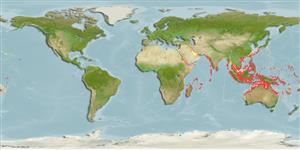>
Kurtiformes (Nurseryfishes, cardinalfishes.) >
Apogonidae (Cardinalfishes) > Apogoninae
Etymology: Taeniamia: Name from feminine Latin noun 'taenia' meaning ribbon or band; and feminine Greek noun 'Amia' meaning a fish, often used with cardinalfishes genera. Here as Taeniamia referring to the vertical wide bars and near vertical to curved narrow bars as lines on most of the species in this genus.; fucata: From the Latin for iridescence in reference to its iridescent body color..
Issue
Apogon sansibaricus Pfeffer, 1893 is considered a valid species as Taeniamia sansibaricus in Ref. 96888.
Environment: milieu / climate zone / depth range / distribution range
Ekologi
marina revassocierade; djupintervall 2 - 60 m (Ref. 9710). Tropical; 30°N - 23°S
Indo-Pacific: Persian Gulf (Ref. 68964); Red Sea and east coast of Africa, eastward to the Marshall Islands, Samoa and Tonga; north to Ryukyu Islands; south to northern Australia.
Size / Vikt / Age
Maturity: Lm ? range ? - ? cm
Max length : 10.0 cm TL hane/ej könsbestämd; (Ref. 48635); common length : 5.9 cm SL hane/ej könsbestämd; (Ref. 37816)
Taggstrålar i ryggfenan (totalt) : 7; Mjukstrålar i ryggfenan (totalt) : 9; Taggstrålar i analfenan: 2; Mjukstrålar i analfenan: 15 - 18. Diagnosis: Dorsal VII,9; Anal II,15-17 (rarely 18); Pectoral rays 14 (rarely 13 or 15). Gill rakers 4-8 + 14-18 (total 19-25). Lateral-line scales 25+3-6. Median predorsal scales 6-7 (rarely 5). Body depth 2.3-2.9 in SL; body width 2.1-2.8 in body depth; eye diameter 2.7-3.5 in head length; first dorsal spine 1.5-2.7 in second spine; second dorsal spine 2.0-2.7, and third dorsal spine 2.2-2.7 in head length; spine of second dorsal fin 2.3-2.9, and second anal spine 2.5-3.2 in head length; pelvic-fin length 4.25-5.2 and caudal-peduncle length 4.7-6.8 in SL; distance from insertion of pelvic spine to anal-fin origin 3.9-5.6 in SL. Posterior preopercular edge variable, usually with few or no serrae above angle; ventral preopercular edge serrate on posterior two-thirds. Scaly sheath along anal-fin base moderately developed (Ref. 54391).
Inhabits continental and insular shelves; on coral and rocky reefs in sheltered bays and lagoon, patch reefs, with muddy, sandy and silty bottoms or coral rubble, and mangroves (Ref. 54391); typically forming dense aggregations at the entrance of caves (Ref. 1602, 48635) and among branching corals (Ref. 2334). Nocturnal species (Ref. 7300).
Life cycle and mating behavior
Maturities | Reproduktion | Spawnings | Egg(s) | Fecundities | Larver
Are mouthbrooders (Ref. 240). Distinct pairing during courtship and spawning (Ref. 205).
Gon, O. and J.E. Randall, 2003. Revision of the Indo-Pacific cardinalfish genus Archamia (Perciformes: Apogonidae), with description of a new species. Indo-Pac. Fish. (35):49 p. (Ref. 54391)
IUCN Red List Status (Ref. 130435)
Threat to humans
Harmless
Human uses
Verktyg
Special reports
Download XML
Internet-källor
Estimates based on models
Preferred temperature (Ref.
123201): 25.1 - 29.1, mean 28 °C (based on 1030 cells).
Phylogenetic diversity index (Ref.
82804): PD
50 = 0.5001 [Uniqueness, from 0.5 = low to 2.0 = high].
Bayesian length-weight: a=0.01202 (0.00712 - 0.02029), b=3.08 (2.93 - 3.23), in cm total length, based on LWR estimates for this species & (Sub)family-body (Ref.
93245).
Trofisk nivå (Ref.
69278): 3.5 ±0.50 se; based on food items.
Resiliens (Ref.
120179): Hög, lägsta populationsfördubblingstid mindre än 15 månader (Preliminary K or Fecundity.).
Fishing Vulnerability (Ref.
59153): Low vulnerability (10 of 100).
Nutrients (Ref.
124155): Calcium = 138 [69, 224] mg/100g; Iron = 0.979 [0.563, 1.703] mg/100g; Protein = 18.6 [17.4, 19.8] %; Omega3 = 0.138 [0.076, 0.244] g/100g; Selenium = 36.9 [18.6, 72.2] μg/100g; VitaminA = 56.2 [16.0, 203.9] μg/100g; Zinc = 1.7 [1.1, 2.5] mg/100g (wet weight);
